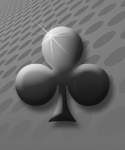|
|

Draw -
1. An unmade hand.
2. A type of poker game.
A “draw” refers to an unmade poker hand, which requires one or more cards to complete. Two common types of draws are straight draws and
flush draws. A straight draw can be further
described as a gutshot, double gutshot, or
open ended straight draw. A gutshot straight draw, also sometimes called an “inside” or
“belly buster” straight draw, is a four card straight
with a card missing in somewhere in the middle. For example, a player who held 4-6-7-8, or 9-T-Q-K would have a gutshot straight draw. A
gutshot straight draw, by definition, can be completed with only one card, making it inferior to both a double gutshot or open ended
straight draw. A double gutshot straight draw refers to a straight draw which can be completed by filling in either of two inside gaps in
the run of cards. An example of a double gutshot draw would be 3-5-6-7-9, where the player could complete the straight by catching either
the 4 or the 8. An open ended straight draw can be completed by hitting a card on either end of the four card run. For example, a player
holding 5-6-7-8 could complete their straight by hitting either the 4 or the 9.
A completed flush contains five cards of the same suit. A flush draw, sometimes called a four-flush, contains four suited cards, and a
player may complete it by hitting any card of that suit. Sometimes a player will have only three suited cards, and will complete the
flush by hitting their suit on successive cards. This is called a runner-runner flush. For this reason, a three card flush draw is
referred to as a runner-runner flush draw. This type of draw has a low probability of completion, and should generally not be taken
unless pot odds exist.
When a player is “on a draw,” it usually refers to a flush or straight draw. This is somewhat of an all or nothing proposition; these
are strong hand when they are completed, but are usually worthless when they are not. When a flush draw is missed it is called a
“busted flush draw.” Similarly, when a straight draw is missed, it is called a “busted straight draw.” These are very weak hands to
finish with, and they rarely win, because they often do not even contain a pair.
Although the term “draw” most commonly refers to flush draws and straight draws, it can be used anytime a player is behind, but has
outs to win the hand. For example, if a player holds K-K-Q-Q, and is up against 3-3-3, he has any of the remaining kings or queens as
his outs, and therefore is considered to be “drawing at” the player holding three of a kind. If the player with the weaker hand
catches the card he needs to win the hand, he is said to have “drawn out” or
“sucked out” on the other player.
“Draw” is also a category of poker games. The three main categories are Flop (of which Hold’em is an example), Stud (of which Seven Card
Stud is an example), and Draw (of which
Lowball is an example). Flop games use a mix of
hole cards, which are each individual player’s private concealed cards, which are delivered face down, and community cards, which are
cards placed face up on the table for all players to share. Stud games also have a mix of cards delivered face up and face down, but
each individual player receives his own cards.
Community cards are not used in stud except in
the rare occasion when there are not enough cards remaining in the stub for the dealer to complete the deal. Draw poker does not have cards
delivered face up. In this category of poker games, players “draw,” which means that they discard the cards that they do not want and receive
replacement cards from the deck. The dealer keeps the discards face down and out of play in a separate pile. Since there are no cards delivered
face up, players must gain information about their opponents’ hands by remembering which cards they have discarded and taken out of play, and
by paying attention to their opponents betting patterns.
The popularity of draw poker waned in the later part of the Twentieth Century, when stud, and more recently
flop games became popular.
For the most part, draw poker is a dinosaur game, and isn’t played much in casinos anymore, although some casinos still spread
Lowball. There are some notable exceptions to this. Mix games have become very popular, especially at the higher limits. Mix games are
games in which several types of poker games are played in sequence, and often include a variety of draw poker. Both
Badugi and Deuce
to Seven Triple Draw are popular draw games often played in a mix game.
Usage: Take The Draw, Drew Out On, Triple Draw, After The Draw, Drawing To A Flush
Previous Poker Term: Double Gutshot
Next Poker Term: Equity |
|









